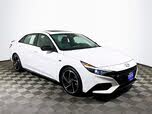2020 Dodge Charger vs 2021 Hyundai Elantra
Overview | ||
MSRP | $29,995 | $19,650 |
Average price | $26,439 | $17,255 |
Listings | ||
Ratings & Reviews | ||
User reviews | ||
Expert reviews | 8.5 out of 10Read full review | 8.8 out of 10Read full review |
Pros & cons | Pros
| Pros
|
Summary | The Dodge Charger represents an all-in-one approach to modern performance. Unlike its Challenger coupe counterpart, the Charger is a sedan, providing the usability of four full doors and five-passenger seating. It offers a wide variety of potent powertrains, as well as the availability of all-wheel drive (AWD). The Charger also provides the latest tech and infotainment features. It may be a classic nameplate, but it is a very different approach to the family sedan. This also makes it a breath of fresh air in the modern sedan market. Thanks to its wide variety of performance models, the Charger's exact competition is hard to pin down. V6-powered versions like the SXT and GT compete with the likes of the Toyota Avalon, Nissan Maxima, and Chevrolet Impala. But the available performance on tap with R/T and Hellcat models opens it up to a world of sports cars and muscle cars. Which model you select determines its rivals. No matter the trim selected, the Charger provides a baseline of athleticism paired with a spacious cabin, large rear seats, and a large trunk. Together, these make the Charger a fun and functional new car, with styling that helps it stand out in a crowd. | Compact cars are no longer compact. Cheap cars are no longer cheap. And it is no longer necessary to buy a luxury vehicle for performance, technology, and sophistication. The redesigned 2021 Hyundai Elantra proves it. |
Video | No video found | |
Popular Features & Specs | ||
Engine | 3.6L 292 hp V6 | 2.0L 147 hp I4 |
Drive Train | RWD | FWD |
Seating Capacity | 5 | 5 |
Horsepower | 292 hp @ 6350 rpm | 147 hp @ 6200 rpm |
MPG City | 19 | 31 |
MPG Highway | 30 | 41 |
Engine | ||
Engine Name | 3.6L 292 hp V6 | 2.0L 147 hp I4 |
Torque | 260 lb-ft @ 4800 rpm | 132 lb-ft @ 4500 rpm |
Horsepower | 292 hp @ 6350 rpm | 147 hp @ 6200 rpm |
Drivetrain | RWD | FWD |
Fuel Economy | ||
MPG City | 19 | 31 |
MPG Highway | 30 | 41 |
Interior | ||
Seating Capacity | 5 | 5 |
Safety | ||
Front Crash Overall | 4 | |
Side Crash Overall | 5 | |
Dimensions & Capacity | ||
Cargo Space | 16.5 cu ft | 14.2 cu ft |
Curb Weight | 3964 lbs | 2725 lbs |
Height | 57.8 in | 55.7 in |
Length | 198.4 in | 184.1 in |
Width | 82.7 in | 71.9 in |
Wheelbase | 120.0 in | 107.1 in |
Maximum Payload | 1136 lbs | 1133 lbs |
Number of doors | 4 | 4 |
Maximum Towing Capacity | 1000 lbs | |
The 2020 Dodge Charger, with its roots tracing back to 2006, carried a modern muscle car silhouette that evolved significantly over the years. By 2015, the Charger had undergone a major facelift, featuring a thin inlet grille and more aggressive headlights, aligning perfectly with Dodge's identity as a modern American performance brand. Inside, the Charger blended retro themes with modern technology, offering a cockpit-like feel due to its raised transmission tunnel and large vintage-looking bezels housing digital displays. The trim levels ranged from the base SXT to the high-performance Hellcat, each adding unique features and visual touches, such as larger wheels, dual-zone climate control, and advanced infotainment systems.
In contrast, the 2021 Hyundai Elantra embraced Hyundai’s Sensuous Sportiness design language, characterized by sharp creases and dramatic angles. The Z-shaped dent in the doors was a standout feature, breaking conventional design rules to give the Elantra a unique character. The Elantra came in SE, SEL, N Line, and Limited trims, with a hybrid powertrain option for the SEL and Limited. Inside, the Elantra featured a driver-focused dashboard and center console, with higher trims offering upscale materials and advanced technology. The Limited and Hybrid Limited trims, in particular, boasted a modern and upscale look with light gray interiors that contrasted starkly with the otherwise black cabin.
The 2020 Dodge Charger offered a range of powertrains, starting with a 3.6-liter V6 engine in the SXT and GT trims, producing 292 and 300 horsepower, respectively. The R/T trim featured a 5.7-liter Hemi V8 with 370 horsepower, while the R/T Scat Pack boasted a 6.4-liter Hemi V8 with 485 horsepower. The top-tier Hellcat came with a supercharged 6.2-liter V8, delivering a staggering 707 horsepower. All engines were paired with an 8-speed automatic transmission, with rear-wheel drive as standard and all-wheel drive available on the SXT and GT. The Charger’s performance was further enhanced by features like Brembo brakes, adaptive suspension, and the Performance Pages system, which allowed drivers to monitor and customize various performance metrics.
The 2021 Hyundai Elantra offered a variety of powertrains, including a 2.0-liter 4-cylinder engine with 147 horsepower in the SEL trim, a 1.6-liter hybrid powertrain with 139 horsepower in the Limited Hybrid, and a turbocharged 1.6-liter engine with 201 horsepower in the N Line. The high-performance Elantra N featured a turbocharged 2.0-liter engine with 276 horsepower. The Elantra’s driving experience varied across trims, with the standard engine providing adequate power for city driving, while the N Line and N trims offered a more engaging and sporty drive. The Elantra Hybrid impressed with its instant torque and fuel efficiency, although it fell short of EPA estimates in mountainous driving conditions.
The 2020 Dodge Charger stood out for its spacious interior, offering ample legroom for rear passengers and well-bolstered front bucket seats. The Charger’s trunk was also notably large, with 16.5 cubic feet of space, making it practical for both performance enthusiasts and families. The interior featured helpful storage solutions, including door trays, cup holders, and a center console with quick and easy access.
The 2021 Hyundai Elantra, classified as a midsize car by the EPA, provided a roomy interior with a height-adjustable driver’s seat and a tilt/telescopic steering wheel. The rear seat offered best-in-class legroom, although the backrest shape and angle could be improved for better upper back support. The Elantra’s trunk measured 14.2 cubic feet, and the 60/40-split folding rear seat added to its utility. However, the lack of air conditioning vents and USB charging ports for rear-seat passengers was a drawback.
The 2020 Dodge Charger came standard with a 7-inch touchscreen infotainment system, with higher trims featuring an 8.4-inch screen. The Uconnect system was praised for its simplicity and ease of use, with a lower dock of icons for quick access to various functions. The system supported Bluetooth, USB connectivity, satellite radio, HD radio, Apple CarPlay, and Android Auto. The digital display screen in the instrument panel provided easy access to trip information, vehicle settings, and navigation.
The 2021 Hyundai Elantra featured an 8-inch touchscreen infotainment system in the SE, SEL, and N Line trims, with wireless Apple CarPlay and Android Auto. The Limited trim upgraded to a 10.25-inch touchscreen with navigation and a 10.25-inch digital instrumentation screen, offering a high-tech and visually impressive setup. The Limited Hybrid’s voice recognition system had some inconsistencies, but the overall technology package, including a Bose premium sound system and Hyundai Digital Key, was impressive.
The 2020 Dodge Charger came with standard safety features like front- and side-impact airbags, traction control, and rear parking sensors. Optional safety features included forward-collision avoidance, lane-departure warning, lane-keeping assist, adaptive cruise control, and automatic high-beams. The Charger’s crash prevention technology earned a Superior rating from the IIHS, although many of these features were optional rather than standard.
The 2021 Hyundai Elantra was built on a new platform designed to absorb and disperse collision energy. Every Elantra came with Hyundai’s SmartSense suite of advanced driving assistance systems, including forward collision warning, automatic emergency braking, lane-departure warning, lane-keeping assistance, lane-centering assistance, automatic high-beam headlights, and a driver attention warning system. Additional safety features included blind-spot warning, rear cross-traffic warning, Rear Occupant Alert, and Safe Exit Warning. Higher trims offered cyclist detection, junction turning assistance, adaptive cruise control, rear automatic braking, and Highway Drive Assist.
CarGurus highlights

According to CarGurus experts, the overall rating for the 2020 Dodge Charger is 8.5 out of 10, while the 2021 Hyundai Elantra scores 8.8 out of 10. Based on these ratings, the 2021 Hyundai Elantra is the recommended choice, offering a more modern design, advanced technology, and comprehensive safety features.
Choose the 2020 Dodge Charger if:
Shop Now- You prioritize high-performance driving with powerful V8 engine options.
- You need a spacious interior with ample legroom and a large trunk.
- You appreciate a blend of retro and modern design elements in the cabin.
Choose the 2021 Hyundai Elantra if:
Shop Now- You want a stylish and distinctive compact sedan with advanced design features.
- You value fuel efficiency and the option of a hybrid powertrain.
- You seek a high-tech interior with advanced infotainment and safety features.

By: CarGurus + AI
At CarGurus, our team of experienced automotive writers remain at the heart of our content operation, conducting hands-on car tests and writing insightful guides that are backed by years of industry experience. To complement this, we are harnessing AI to make our content offering more diverse and more helpful to shoppers than ever. To achieve this, our AI systems are based exclusively on CarGurus content, ratings and data, so that what we produce is both unique to CarGurus, and uniquely helpful to car shoppers.






























